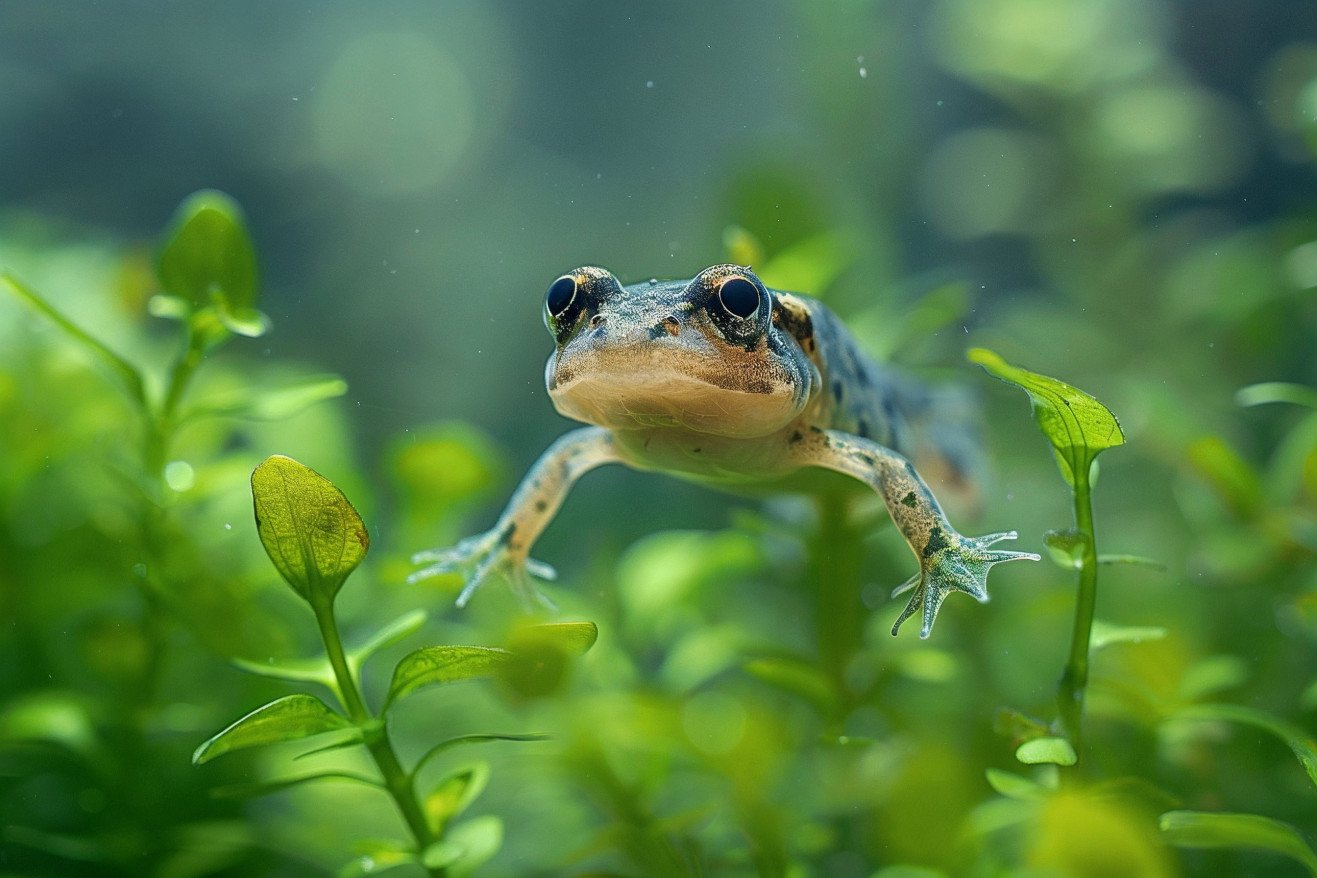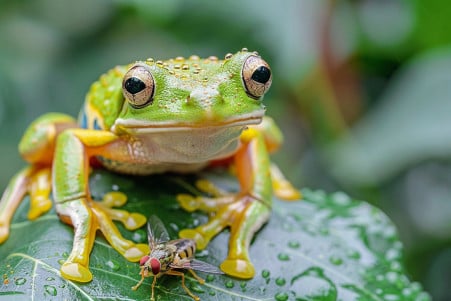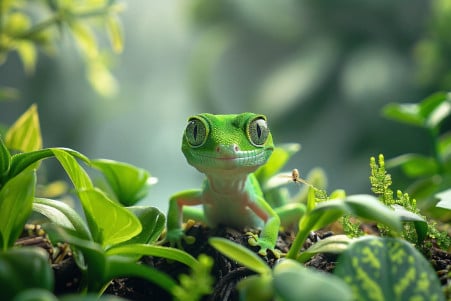What Do Tadpoles Eat? An In-Depth Look at Tadpole Diets and Development
7 March 2024 • Updated 7 March 2024

Tadpoles undergo a fascinating transformation from water-dwelling larvae to land-dwelling frogs, and their diets change significantly during this time. Tadpoles primarily eat algae and other plant-based foods in their aquatic environments, but as they grow, they become carnivorous and eat insects, snails, and worms. Even after they’ve completed metamorphosis, they still eat small invertebrates as adult frogs.
In this article, we’ll take a deep dive into the research on the diets of tadpoles, including ecological and developmental biology research. This research has shown how tadpoles’ feeding behavior changes as they develop, the nutritional value of the foods they eat, and the environmental variables that impact the availability of their food.
By the end of this article, you’ll have a thorough understanding of how important nutrition is to the development and survival of tadpoles.
What do tadpoles eat?
Tadpole Diet in Aquatic Ecosystems
Tadpoles are found in a variety of aquatic habitats, and they are primarily herbivorous during their time in the water. In fact, a study in Freshwater Biology notes that understanding the trophic level and diet of tadpoles is important for understanding their functional role in freshwater ecosystems.
Algae and biofilm are the primary food sources for tadpoles, and both are highly diverse and nutrient-rich. Biofilm is a complex matrix of microorganisms and organic matter. In addition to providing energy, these food sources are also nutrient-dense, which is important for the growth and immune system of tadpoles.
A study in The Australian Journal of Zoology even suggests that biofilm is the most important component of the tadpole diet, due to its high nutritional value and widespread availability.
The availability of algae and biofilm impacts tadpole growth and development. High levels of these food sources can lead to faster growth and better health, while low levels can slow these processes.
Despite the common belief that tadpoles are omnivorous or even carnivorous from the time they hatch, gut content and stable isotope analysis show that tadpoles’ diet in floodplain wetlands is mostly herbivorous during the larval stage. As a result, the importance of a nutritious, herbivorous diet in their aquatic nursery is critical to their development and sets them up for a lifetime of diverse diets.
Metamorphosis and Dietary Shift
A baby frog goes through a critical metamorphosis, which is when the tadpole undergoes extreme anatomical and physiological changes that ultimately lead to the froglet becoming an adult frog.
This process is highly associated with a dietary shift, which goes from an herbivorous diet that mainly consists of algae and biofilm to a carnivorous diet that includes insects and small invertebrates.
A study in Environmental Toxicology and Chemistry even suggests that dietary quality is important for this complex shift, especially in relation to the thyroid axis, which is responsible for controlling metamorphosis. The tadpole’s dietary needs change as it grows, and it eventually needs a diet that can support its increased energy needs and the growth of new organs.
A study in Frontiers in Microbiology shows that the frog’s gut microbiome changes to meet the demands of this new diet by increasing the number of bacteria that can digest fat and chitin.
The success of metamorphosis and the survival of froglets is highly dependent on getting the right nutrients at the right times.
The study shows that limiting diets can lead to delays in development, which shows that the right amount and timing of nutrition is important. The quality of the diet that froglets eat as they move through their life stages continues to be important for their growth, immune function, and overall health.
What Tadpoles Need to Eat and How Food Quality Matters
Tadpoles consume a variety of nutrients that are important for their development into adult frogs.
Algae and biofilm, which are the main sources of food for tadpoles, provide the energy tadpoles need to survive and grow, as well as the nutrients that are important for their development.
A paper in BMC Developmental Biology explains that the gut morphology of tadpoles that are carnivorous has structural adaptations, which suggests that animal protein is an important part of their diet.
The nutritional quality of the basic food sources that tadpoles eat, such as algae, has been shown to impact tadpole growth and the development of their immune systems. In addition, a study in PMC explains that the gut microbiota is important for tadpole nutrition and development. Tadpoles’ relationships with their gut bacteria are important for their ability to digest their food and absorb the nutrients they need.
Poor nutrition, whether it’s due to a lack of an adequate diet in the wild or the poor quality of commercial tadpole food, can have serious impacts on tadpoles’ health and development. A paper in Freshwater Biology explains that it’s important to understand tadpole trophic ecology in order to help with ecological research and conservation.
It’s important to make sure that tadpoles are getting the nutrition they need to survive and thrive in their sensitive aquatic environments.
How Water Quality and Nutrition Interact
Water quality, which includes pH, temperature, and pollutants, is one of the most important factors that determines what tadpoles eat. For example, a study in the Journal of Comparative Physiology found that Rana arvalis tadpoles had different behavioral and physiological reactions to pH and predator stress, which means that environmental factors directly affect what they eat and how they grow.
Meanwhile, ScienceDirect notes that lead pollution can affect tadpoles’ growth and immune response, and it can also degrade water quality, which can change the availability and composition of their food.
Habitat destruction and climate change also threaten tadpoles by changing their food supply. A meta-analysis by Rick A. Relyea in PMC found that exposure to a variety of pollutants reduced amphibian survival and mass, showing that tadpoles are very sensitive to their environment. These factors can combine to create nutritional deficiencies that affect the availability of the nutrients that tadpoles need to grow and metamorphose.
This is why conservation is so important. By protecting water quality and the health of ecosystems, conservationists can make sure that tadpoles have the nutrients they need to grow and eventually help maintain the biodiversity of their environment. Knowing the complex interactions in these ecosystems can help conservationists develop strong strategies to protect these animals and their complex life cycles.
Tadpole Diets: From Algae to Insects
In learning about the life of tadpoles, it is evident that their diet is important from the moment they are born. A diet of algae and biofilm is important for the growth and development of tadpoles. However, as they grow and develop, their dietary needs change and they eventually become carnivorous, eating insects and small invertebrates.
The role of nutrition in the growth and development of tadpoles is vital. Each meal is a step toward the tadpole’s ultimate goal of becoming a frog. Unfortunately, environmental factors such as water quality, pollution, and the destruction of natural habitats can all impact the availability and quality of the food that tadpoles eat.
This is where ecological research and conservation come in. These studies are essential in helping to protect the growth and development of these interesting animals. They help us understand the needs of tadpoles and help us ensure that the habitats they live in can provide them with the diverse diet they need.
In summary, it’s important to recognize the role that diet plays in the life cycle of frogs. A diverse diet is essential to their survival, and our knowledge and efforts can help ensure that these amazing amphibians will be around for years to come.


